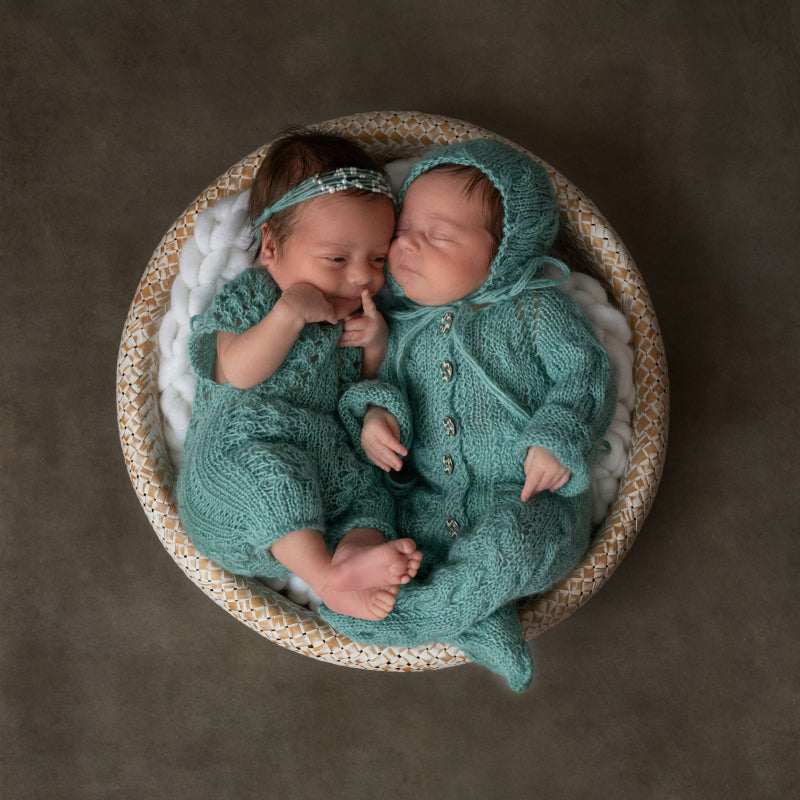Cloth Diapers for Twins – How Many Diapers Do You Need for Multiple Children?
Updated on:
Photo by Liviu Boldis on Unsplash
As soon as a baby is on the way, you'll need to plan and organize. For parents of twins, diapering presents a special challenge, as everything has to be organized twice – from the supply of diapers to the time management.
Do I need double the amount of cloth diapers for twins? For twins, you will need more cloth diapers, but not necessarily double the amount. Since covers in cloth diapers like Judes can be used multiple times, you can alternate them. However, for the number of inner diapers, you should account for the daily need per child to be sufficiently equipped for both.
Diapering with cloth is a sustainable and practical option for two babies that can be easily integrated into daily life. But how many cloth diapers are needed for twins and what system is best suited? In this article, you'll learn how to calculate the need, which cloth diapers are suitable for twins, and how to make diapering efficient.
How many cloth diapers do you need daily for twins?
The number of cloth diapers you need daily for twins depends on various factors. In addition to the age of the babies, the type of diaper you choose also plays a role. Are you diapering exclusively with cloth or combining cloth and disposable diapers? Equally important is the frequency of diaper changes, which is often higher for newborns than for older babies.
Average diaper use for newborns
Newborns need about 7 to 12 diapers a day in the first weeks. This means you need up to 24 cloth diapers daily for twins if you're only using cloth. With a clever diaper like Judes, where covers can be used multiple times, the number of covers you need is significantly lower.
However, this does not mean you need double the amount of diapers overall – with a well-thought-out washing routine and the multiple use of covers, you can optimize your stock. It is important to have a sufficient supply of appropriate cloth diapers for newborns for the first weeks to enjoy relaxed diapering days.
Changes in diaper use for older babies
From about 6 months, the daily need decreases to an average of 5 to 8 diapers per child. Factors such as the introduction of complementary foods or increased mobility can affect the frequency of changes. Cloth diapers offer an advantage here, as due to their high absorbency, they often need to be changed less frequently.
Parents of older twins also benefit from the flexibility and adaptability of modern cloth diapers like Judes, which grow with your baby. This keeps diapering practical and manageable, even if both children develop different needs.
How to plan the cloth diaper supply for multiple children?
For parents of twins or multiples, it is important to plan the cloth diaper supply well. It is not only about how many diapers are needed per day, but also how often they are washed and how the diapers are stored in between. With a well-thought-out system, you can avoid shortages and make your daily diapering routine efficient.
Calculating the supply for a week
A simple calculation helps to determine the weekly need. With approximately 10 cloth diapers per day for one baby, you can estimate a usage of about 20 diapers per day for twins. This amounts to a total of 140 diapers for 7 days. If washed every 3 days, you should have at least 60 diapers in stock to always have enough clean diapers available.
Additionally, you should use diaper bags or buckets for storage until the next wash cycle. Products like the Judes diaper bag facilitate hygienic storage until washing. A wash interval of 2 to 3 days is ideal to prevent shortages.

Photo by olivia_greige
|
Number of children |
Total cloth diapers |
Clean diapers in stock |
Washing interval |
|
One child |
50–60 |
20–30 |
2–3 days |
|
Twins |
100–120 |
40–60 |
2–3 days |
|
Triplets |
150–180 |
60–90 |
2–3 days |
|
Quadruplets |
200–240 |
80–120 |
2–3 days |
Tips to avoid shortages:
- Planning wash intervals: Start with enough diapers for at least 2 days to stay flexible.
- Combined systems: Use covers multiple times and invest in additional inner diapers.
- Hygienic storage: Store used diapers in breathable diaper bags or buckets to minimize odors.
With the right planning, you don't need to worry about using cloth diapers, even for multiple children, and you can optimally organize your daily life.
Choosing the right diaper
Choosing the right cloth diaper for twins or multiple children is crucial to make the diapering routine more efficient. Judes cloth diapers offer numerous advantages, especially significant when it comes to double the need.
Advantages of the Judes:
- Easy handling: Judes cloth diapers consist of an absorbent inner diaper and a waterproof cover. This two-piece system allows for quick and easy diapering – just as simple as using disposable diapers.
- Less laundry work: The cover can be used multiple times before it needs to be washed. This reduces the laundry load and saves time, especially with multiple children.
- Flexible size adjustment: With only two sizes (Size 1 for babies up to about 8 kg and Size 2 from about 7 kg), Judes fit throughout the entire diapering period. This also makes it ideal if twins have different body sizes or weight progressions.
- Lower cost: Thanks to durable materials and the ability to use them for subsequent children, Judes cloth diapers are also a financially sustainable choice.
With the well-thought-out cloth diaper from Judes, organizing for twins or multiples is easier. The flexible fit prevents leaks and the absorbent inner diaper keeps reliably dry even at night.
By combining easy handling and innovative design Judes make family life easier – whether for one baby or for twins.
Diapering in practice: How to save time and effort when diapering twins

Photo by @cafema.illustration
Diapering twins means double the need, but that doesn't necessarily mean double the work. With good organization and clear procedures, the diapering routine can be efficient and relaxed. The key is to create a system that simplifies the process and saves time in the process.
Strategies for efficient diapering
A well-organized diapering area is the centerpiece for relaxed diapering. For twins, a double station can be sensible – meaning two changing pads or a large changing area where both babies can be placed side by side. Alternatively, a single station with clearly structured processes is sufficient to save time.
Tips for organization:
- Keep all supplies within reach: Ensure that diapers, wipes, and spare clothes are accessible. Sort them into labeled boxes or compartments to avoid confusion.
- Clear procedures: Determine who changes which baby and when. This creates routine and avoids stress.
- Additional aids: Use practical products like diaper bags for used cloth diapers to store everything quickly and hygienically.
With Judes' cloth diapers, you save time, as the cover can be used multiple times and the handling is just as easy as with disposable diapers. Thanks to the well-thought-out design, you can change both babies quickly without compromising on comfort or hygiene.
Further tips for the perfect diaper changing table setup can be found on our blog.
Washing and drying made easy
Washing and drying cloth diapers for twins doesn't have to be complicated – with the right routine, it becomes a convenient part of your daily life. A full machine load saves time, water, and energy, while Judes cloth diapers' simple washing routine makes the process even easier.
Efficient washing process
- Full machine load: Collect used inner diapers and covers in a breathable diaper bag until you have a full machine load. Make sure not to store the diapers unwashed for longer than 3–4 days to avoid odors and stains.
- Optimal washing routine: Use a gentle and eco-friendly cloth diaper detergent, like Judes Family Care. Wash inner diapers at 60°C to effectively remove germs. The covers can also be easily added to the machine.
In our blog, we also give you tips for storing cloth diapers properly.
Drying with minimal effort
- Air drying: Air drying inner diapers and covers is the gentlest method. Hang them in a well-ventilated place, ideally outside.
- Machine compatibility: When you need them to dry quickly, Judes can also simply be dried in the dryer.
- Practical tricks: Use drying racks with clips or clotheslines to save space. Hang inner diapers in the sun to naturally bleach stains.
Learn more about drying in our article: how to dry cloth diapers properly.
Hygiene and sustainability
- Remove residues: Ensure all detergent residues are thoroughly rinsed out to protect your baby's sensitive skin.
- Longevity of the diapers: Regular care extends the lifespan of your cloth diapers, so they can also be reused for siblings.
With these tips, washing and drying washable diapers for multiples becomes hygienic, time-saving, and sustainable.
Sustainable advantages of cloth diapers for twins compared to disposables

Photo by @jasminstadlhofer
Diapering twins not only means a higher diaper consumption but also double the costs and waste quantities – at least if you're relying on disposable diapers. Cloth diapers are a sustainable and long-term cost-saving alternative that protects both the environment and your wallet.
Lower cost than disposable diapers
Diapering twins with cloth diapers offers not only environmental benefits but also significant savings. The initial purchase costs are higher, but in the long run, the reusability and durability of cloth diapers pay off.
Disposable diapers vs. cloth diapers for twins:
- Disposable diapers: An average baby needs around 5,000 diapers until they are potty trained. For twins, that's 10,000 diapers.
- Cost per piece: approx. €0.32.
- Total cost for 3 years: approx. €4,902 (with 7 diapers daily per child).
- Cloth diapers (Judes): Our Premium Set All-In is available for €1,905 and it covers both children throughout the diapering period.
- Ongoing costs for detergent and water: approx. €200 per year.
- Total cost over 3 years: approx. €2,505.
Savings:
With cloth diapers, you save about €2,400 for twins compared to disposable diapers. If you use the diapers later for other children or sell them, the savings increase even more. Not included in the calculation are wipes, trash bags, and disposal costs. With cloth diapers, you avoid trash bags and disposal costs, and wipes can be replaced by sustainable and reusable washcloths, which further increases savings.
In our article “Costs of cloth diapers compared to disposable diapers" you will find detailed information about the cost comparison.
Environmentally friendly through reduced waste
Disposable diapers not only result in high ongoing costs but also significant waste. Each baby produces up to about 1,000 kg of plastic waste until they are potty trained – for twins, that's 2,000 kg, which do not decompose for centuries. But that's not all: Since disposable diapers do not break down due to the chemicals they contain, they end up in incineration plants. Even after incineration, a toxic mass remains, which is stored in disused mines, continuing to harm the environment.
Cloth diapers save resources:
- Less waste: Judes cloth diapers can replace hundreds of disposable diapers and be used across multiple children.
- Sustainable materials: Judes uses recycled and biodegradable materials that are environmentally friendly and free from pollutants.
- Efficient manufacturing: Judes significantly reduces water and energy consumption compared to disposable diapers.
With Judes, you make a statement for sustainability and make an important contribution to waste reduction. At the same time, you teach your children the importance of environmentally conscious decisions from the start.
Conclusion: Whether twins or multiples, cloth diapers are a good choice!

Photo by @igel.naeherei
Cloth diapers are not only a sustainable and cost-effective choice for one baby but also ideal for multiple children. In particular, the well-thought-out diapers from Judes demonstrates its full benefits when demand doubles. The easy handling, reduced washing effort, and high adaptability make Judes a practical and environmentally conscious solution for families with twins or multiples.
The benefits at a glance:
- Sustainability: Less waste and the use of recycled materials protect the environment.
- Lower cost: One set covers the entire diapering period, saves money, and can be used for additional children.
- Ease of use: Judes can be put on like disposable diapers, reducing everyday effort.
- Health: Breathable fabrics without harmful chemicals promote your baby's well-being.
- Efficiency: The reusable covers and washable inner diapers ensure optimal organization.
Whether for one child, multiples or twins – Judes cloth diapers are tailored to the needs of modern families.

